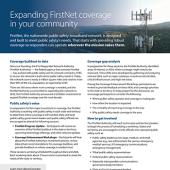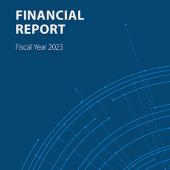This blog is a repost from MissionCritical Communications, originally published on January 10, 2020. The original article can be accessed here.
The Dec. 9 – 13 3GPP meetings were held in Sitges, Spain, and focused on the final work scope and feature set to be standardized in Release 17 (R17). Most of the First Responder Network Authority (FirstNet) objectives were achieved, and the expected freeze date for R17 remains June 2021. LMR to Long Term Evolution (LTE) interworking made big strides as well.
The 3GPP meetings were represented by nearly all major mobile equipment vendors, chip manufacturers, software vendors, and network operators from about 35 countries. In addition, many government agencies representing public-safety interests attended.
Radio Access Network (RAN) Plenary
Technical Specification Group (TSG) RAN is responsible for defining the functions, requirements and interfaces of the 3GPP radio network. The R16 freeze is expected to occur in March 2020 as planned, but the main agenda item was finalizing the R17 work topics. Several topics of interest for the public-safety community were agreed upon for inclusion in R17.
The R17 work topics can be classified into two groups: study items and work items. A study item typically refers to a new feature that may or may not be included in a work item depending on the study results. The work items will lead to the actual technical specifications of the standard.
The R17 study items of interest to public safety include 5G New Radio (NR) positioning enhancements and sidelink relay, a capability to extend coverage. We expect these features to move to the work item phase for completion in R17. The work items of interest to FirstNet that are now officially a part of R17 include the following 5G NR features: sidelink, also known as direct mode, enhancements; non-terrestrial networks (NR-NTN), such as 5G over satellite; multicast broadcast services; and user equipment (UE) power savings.
The NR positioning enhancements study addresses enhancements and solutions necessary to support both higher horizontal and vertical accuracy; low latency; and network and device efficiency requirements, such as power consumption and complexity, for commercial use cases. However, we expect some commercial solutions will be usable for public safety. Sidelink relay will focus on extending on-network, as well as off-network, coverage.
The NR sidelink enhancements work item builds on R16 sidelink work. The objective of this work item is to specify radio solutions that can enhance the NR sidelink for the vehicle-to-everything (V2X), as well as public-safety and commercial use cases. A major focus will be on UE power savings, which will be important for public safety to extend battery life. The NR-NTN work will specify the enhancements to support use over low earth orbit (LEO) and geostationary satellites to extend coverage when needed. 5G multicast-broadcast services work will define multicast-broadcast for UEs in connected, inactive and idle states, enabling public safety to use multicast-broadcast to better use radio capacity in a variety of situations. Finally, the UE power savings work will specify enhancements for idle/inactive-mode UE states that will help first responder UEs maintain a longer battery life.
The third day of the plenary was a joint meeting between the RAN and SA delegates with the objective of aligning the content of the topics selected by each group for R17. This joint meeting helped RAN and SA working groups become aware of areas where more interaction is required between RAN and SA working groups.
SA Plenary
TSG SA is responsible for the overall architecture and service capabilities of 3GPP-based systems. As in the RAN Plenary, significant time was spent on R17 planning and work prioritization.
FirstNet, with the support of AT&T and agencies of eight other governments, continued to advocate for features important to public-safety wireless broadband users worldwide. Although some amount of down scoping was applied, key public-safety features were agreed to be included in R17. These features include proximity services using the sidelink, multicast broadcast services, enhanced location services and satellite access in 5G.
Although it seems that planning was the only focus during the plenary meetings, the real technical work continues in parallel. During the meetings, it was reported that stage 1 R17 requirements were 100% complete. One major item completed was the approval of new multicast-broadcast requirements specifically crafted to enhance public-safety operations. Other items of interest completed for R17 include service requirements for medical applications, enhanced relays including multihop relays and 5G enhancements for unmanned aerial systems (UAS).
For stage 2 architecture work, which mainly involves SA2 and SA6, work was completed on a study for using satellite access in 5G, and significant progress was reported on studies for mission-critical services including location enhancements and architecture enhancements for 5G multicast-broadcast. Finally, a work item on isolated operation for public safety (IOPS) is progressing, and a decision was made to create a new technical specification for mission-critical support in the IOPS mode. IOPS aims to maintain a level of local communications between public-safety users even when the backhaul connectivity to the core network is not fully functional.
Core Network and Terminals (CT) Plenary
The CT work covers the protocol details and follows the requirements and architectural work performed in the Service and System Aspects (SA) working groups. The primary focus was on approval of Release 16 (R16) work.
At the meeting, a major milestone for FirstNet was the approval of the technical specifications for LMR interworking for mission-critical push to talk (MCPTT) on 4G systems. These specifications provide the standards for the 3GPP MCPTT side of voice communications interworking with legacy LMR systems. Work continues in the Alliance for Telecommunications Industry Solutions (ATIS) and Telecommunications Industry Association (TIA) on the LMR side of the interworking effort.
ATIS is delivering a joint LMR and LTE (JLMRLTE) architecture study on interworking between Project 25 (P25) and 3GPP MCPTT mission-critical services. The first of several anticipated phases has been completed and delivered to TIA. On the basis of that input, TIA is progressing with the necessary enhancements to areas such as the Inter RF Subsystem Interface (ISSI) specification that will define the P25 side for interworking with 3GPP.
3GPP work on LMR interworking for mission-critical data (MCData) also continues, with standards approval expected in March 2020. Additional features will continue to be added to LMR interworking in R17. MCPTT, mission-critical video (MCVideo) and MCData will be added to 5G systems in future releases.
5G R16 work is nearing its completion date of March 2020. FirstNet led the work on mission-critical priority in a 5G system, which was also approved, providing high priority for first responders over 5G networks.




















